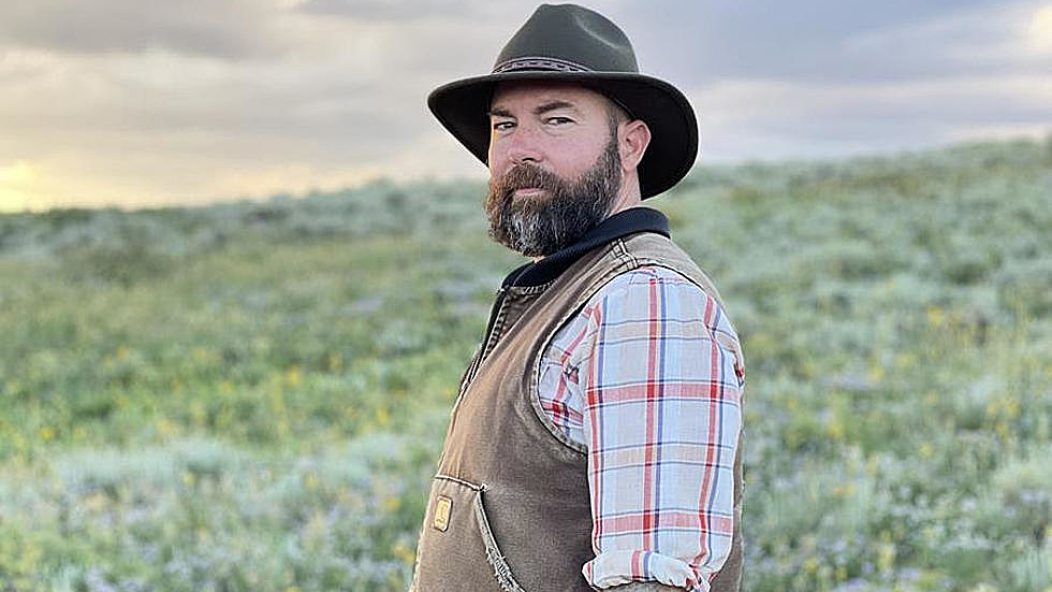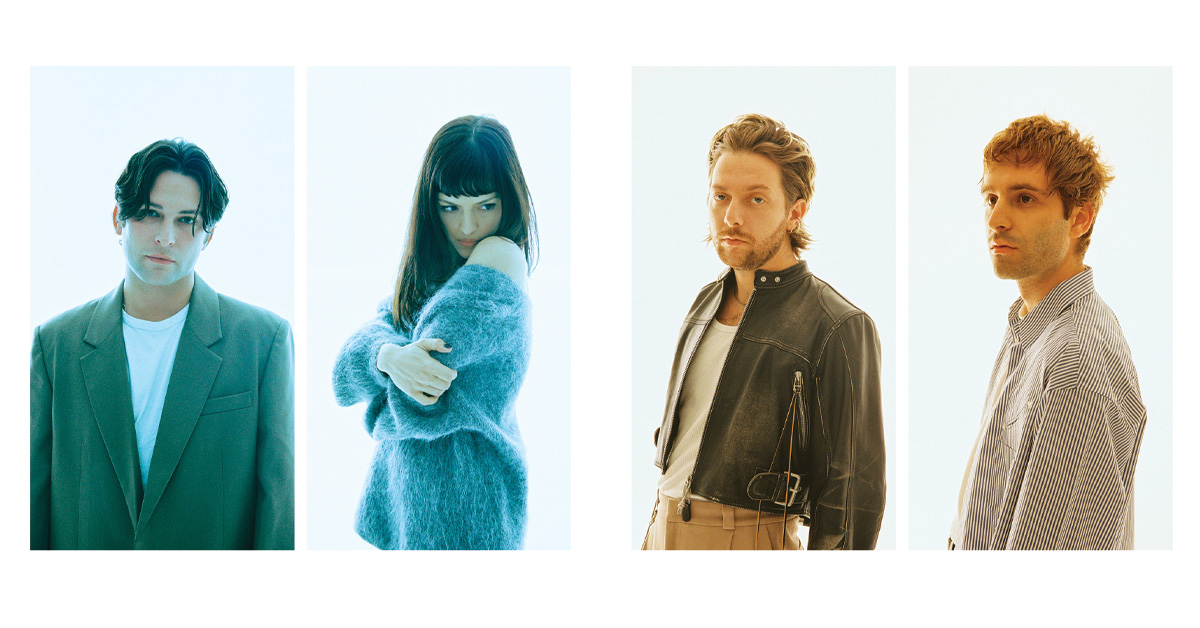
Unknown Gnosis: An Interview with Russian Circles' Brian Cook
Russian Circles‘ Gnosis is an exploration of space and time: it’s the bedrock blasted to bits to lay the foundation for another Brooklyn condominium. It’s the Earth pulsating around the mouth of a geyser. It’s the cold front moving in from all directions, dropping the temperature below freezing and changing the way we move through the world. The cover of the album depicts two men, isolated on a cubic column of scaffolding. Devoid of background, it leaves the viewer unhinged, but also suggests possibility: you can fill in the blanks and the structure can become whatever you want it to be. Gnosis is like that: the songs swell and expand, with room to move around. You get the opportunity to fill in those spaces, to wander the hallways of a building that never seems to have an end; to bushwhack through a cold, Northwestern forest, perpetually wet, vision blurred through the fog.
On the other hand, Sumac’s latest collaboration with Keiji Haino, the gloriously entitled Into this juvenile apocalypse our golden blood to pour let us never could be a companion piece to the rigid structure of Gnosis. If Gnosis is all about construction- about finding land firm enough to mold into our own vision- then Into this juvenile… is about that vision falling apart. It’s a geographic glaucoma: the entropy of the natural world permeates towards chaos, and what we think is together, isn’t necessarily so. You can’t see clearly anymore. It’s like hiking in that Washington wilderness and suddenly realizing you don’t know where you are and instead of freaking out, you feel oddly free. Gnosis is the construction. Sumac is the deconstruction. It’s the constant Yin and Yang of the world we live in. We can change the environment to respond to our needs, but ultimately we’re no match for what the Earth, in all her Gaia-like wisdom, can do to us in the end.
Brian Cook is the singular thread between these two artistic endeavors. His bass–playing weaves the acts together, and his artistic contributions are deliberate, thoughtful and inspired. Over the course of an hour, we talked about the role that geography plays in the development of art, and how this sense of place can inspire us to make sublime, celebratory noise. In addition, we also talked about side two of Black Flag’s album My War; the impact of growing up and living in the Midwest of America on popular music; the swamps of Florida and the tundra of Sweden; and how Russian Circles will never make the next Kid A.
I’ve been really interested in the relationship between geography and music, particularly heavy music: about how the sounds artists are making and listening to is infused by the world they live in, and what this sense of space means in terms of the creative process. Can you talk about this relationship from your own viewpoint as an artist?
I remember going to Europe for the first time in 1999, and I was embarrassed by how little I knew about what was going on in music in Europe at the time. It felt like there was a one-way exportation of cultural capital, where Europeans would investigate and listen to American bands and bring them on tour, but the inverse wasn’t always the case. There were expectations, of course- Swedish death metal, Norwegian black metal, the UK, obviously- but now the Internet has opened things up. It’s leveled the playing field in terms of giving people the ability to get their music out. What does music out of a certain region sound like? Even if there’s this exchange of ideas and cultural influences, I think people are still fascinated by the sounds that come out of certain regions and areas. In the internet age, you run the risk of losing that: there’s no longer that need to be fixated on the local scenes. The era of going out and supporting local bands in your area because that’s what’s there has been replaced by participating in music communities online, meaning geography doesn’t play as big of a role. There’s still a lot of unique flavor in local scenes and countries, in terms of the music they make, but there’s also this global awareness and appreciation for it.
–Stephen Loschi
…
…
What kind of foundation do you think your body of work will leave in terms of the future? There’s this idea that there’s a permanence to an album and a deliberate esotericism to performing live. When you combine these two, you are kind of creating this sonic ecosystem of ideas. Do you find there’s a different purpose to these types of art- the recorded sound vs. the live sound?
If you’re talking records versus shows, it’s a little easier to see the immediacy of the geography in something like that. A record is sort of like this frozen “thing”- not to undermine the making of a record- but my response to music is almost entirely bound up in how it manifests itself in a live scenario. I kind of thought that’s how everyone listens to music! What makes listening to a record interesting is trying to envision how the band is in the room making the music. Like how much of this is a construct and how much of this is the band knocking ideas off of each other? The recording is the photograph; the live experience is the real thing. As bands tour more, they lose a lot of their specific regional legacy, but in their infancy, a band is just a representation of the region. I know a lot of artists have this idea that they are pulling the art out of this metaphorical ether, but you’re limited by what’s available around you and that has a huge influence on the kind of music you produce.
I don’t think you can talk about geography without respecting the architectural space as being part of that. Can you talk about specific rooms you’ve played in that really resonated with you? You often said that Sumac “plays to the room”.
In David Byrne’s book How Music Works he says that the room dictates the kind of music that’s made in that environment. Like you can’t have a jazz band play in a church, because you lose the ‘clutter’ needed to support that sound, and you can’t have a choir play in a jazz club because you lose that acoustic resonance. For Sumac, we found that the acoustics of the room can dictate how the show goes. We do a lot of work with feedback and we push the amps and speakers to a point where they do unorthodox things. On some level, we’re playing off each other: what I’m playing might be dictated by what Aaron is playing and what Aaron is playing might be influenced by what Nick is playing. This ability to hear each other and the idiosyncrasies of what the room is doing will influence what we’re trying to do. In live settings, it can be interesting, because sometimes the more charted out, structured pieces can sound better than the improvisational stuff and on another night, in a different room, the reverse might be true. A lot of times this has to do with just the acoustics and energy of the room.
We’ve done two records up at a studio in Anacortes, Washington called the UNKNOWN. It’s an old 20th century church. It’s a wooden structure- this awesome space with big, roomy natural reverb. I think sometimes engineers struggle to get a tight sound there, but we’ve approached recording with Sumac from a live-angle, so instruments bleeding through isn’t always a bad thing. We also recorded at Robert Lang’s studio, where the first Foo Fighters’ album was done. It’s a studio treatment so everything’s a bit more dry, but it was still a remarkable experience.
When we talk about how the space we are in influences the music we make, we can take this quite literally, as you discussed with the studios you guys have recorded. How do you think this changes as you move away from that immediate space?
That’s more about architecture than geography, of course, but we can zoom out from that and look to see how it appears from there. If you look at Seattle, we’re still living in the wake of the grunge movement, which was like a response to side 2 of Black Flag’s “My War.” When people talk about the Melvins getting their start- combining old classic rock with scummy, antagonistic punk music- it was this transformational moment, based on a show Black Flag played back in the day. You end up with this slow hand, Sabbath-y, down-tuned, grimy riffage delivered by scrappy punk dudes. To some extent, Sumac is an extension of that: it’s an antagonistic sound, not fixated on precision or classical tightness. It’s abrasion and sloppiness- the push and pull as a dynamic function. I don’t look at Sumac as being indebted to ‘grunge’ music, but it’s embedded in your DNA because you live in fucking Seattle, and you were raised on the Melvins and Nirvana and Soundgarden!
I’ve also been listening to a lot of death metal and there’s a difference between American death metal and European bands. There’s such a difference in the level of precision between the bands: American DM is grimy and gross. Even technically proficient artists like Morbid Angel and Cannibal Corpse still keep it dissonant and ugly, whereas the Swedish bands are locked-in and precise. There’s a whole different skill set and proficiency that Europe goes for. It’s the things that are going around that influence the music. If you were in Florida, the music was kind of gross and swampy, and ignorant sounding. If you were in Sweden you got that buzzsaw guitar sound, and probably spent a lot of time inside!
Cold weather will do that.
It does make you wonder if that music could have come out anywhere else. Could grunge have happened anywhere else besides Seattle? Could bands like Morbid Angel and Deicide happen outside of Florida? There were pockets of this happening everywhere, but it happened in these places. Do you think there’s a reason for this?
It raises this interesting question: in art there’s always an exchange of ideas. When someone talks about reinventing the wheel with music, it kind of makes me roll my eyes. That’s not the point. We’re trying to use a common language to add to the conversation: it’s a tradition, and we’re trying to keep things moving forward. Also- as music becomes more and more of a thing that transcends geography and can be shared on a global level- it’s exciting to see the exchange work in two ways. That being said, we worry about cultural appropriation for good reason; however, this can be counter-productive to the artistic process. If the exportation of ideas only works one way, then that seems counter-productive. For instance, I admire the artists who are dabbling with the Western tenets of metal and then incorporating their own traditional, regional ideas into their music. It’s always fascinated me. I’ve always sought out art from unique places.
I mistakenly placed you in Chicago, even though you’re personally 1700 miles to the west in Seattle. But the band does call Chicago “home.” What does that mean to you? What does it mean to be a Chicago “band”?
Chicago has a long legacy of being this big city with very forward thinking artists who are trying to push things, and reexamine the rules and the orthodoxy of rock music, and still be a blue-collar town that likes to go out and drink beer and have a good time. You can have something more high-brow like Tortoise and still have a ‘fun-band’ like Shellac, which is riff-driven but done with an intellectual approach within these established confines of what they do stylistically, and this has rubbed off on us. Tortoise, Shellac, 90-Day Men- these bands deliver this power on stage, with an element of menace, but they still have an air of intelligence about them. There’s a whole lot of thought behind the process.
Having said that, it makes me think it’s a Midwest thing, really. Slint, Don Caballero, Louisville, Pittsburgh: it’s a punk attitude and approach, but with the artist’s willingness to explore. For Russian Circles, while we’ve rarely lived in the same area, we were all born in the Midwest. I was born in Kansas City. Mike was born in Minnesota. I think Dave was born somewhere in Iowa. I was a military kid, so I bounced all around. I think, on some level, when your life is constantly interrupted and you’re thrust into different cities I can see that easily leading to what you listen to as an artist. I spent my adolescence in Hawaii and was a punk rock kid there. Then we moved to Tacoma and I found my tribe there, but the bands both groups listened to were different. You find your people when you move around; but those references can be very different depending on where you are. For Russian Circles, by the time we’d met up in our twenties, we had absorbed all these different ideas, so we wanted to maintain the space to try different things. While we have a template for what we do sonically, it can still encompass something metal-inspired like “Tupilak,” or a song like “Bloom” which is more indebted to the melodic post-rock thing, or a sad folk ballad with Chelsea Wolfe, or a krautrock song.
That’s one of the cool things about metal: it’s so willing to experiment, and yet it works within these narrow parameters. Metal, in particular, likes to put things in little boxes, so it’s thrilling to see bands that push the edges of those boxes, and try and reinvent the genre in their own way by incorporating these unique voices. I think Russian Circles have done a really good job of redefining those edges. It’s much more expansive than the category of ‘post-metal’ or ‘post-rock:’ if I had to define it in terms of geography, you’re much more of a biome than a smaller ecosystem.
You guys have been together since 2004, and you’ve had this really unique opportunity to tour the world. How has touring affected the music Russian Circles make as a trio?
Well, we try to keep our ears open. As a trio, we try to keep a limited amount of instrumentation- we’re not going to turn around and do a Kid A type album. We’ll always be bass, drums, guitar and some synth stuff. That’s just what we are. But within those parameters- and knowing who we are- we do try to keep experimenting and pushing and trying out new ideas. With “Gnosis” there was a singular idea: we wanted to make a heavy metal album. In our eyes, though, even our definitions of metal were pretty broad. For instance, “Tupilak” is our big epic, mid-tempo, cavernous death metal song; “Conduit” is the heavy breakdown thrash-inspired song; “Betrayal” is black metal. There’s this element of harvesting ideas from a broad swath of ideas: this time we were focused on heavy metal.
Being a band that tours a lot, and has been around the world, does affect the way you hear the music. To go on tour, and go to someplace exotic, for instance, and hear a band that sounds like any other American band can be kind of disappointing. It’s way more exciting to see a band that you’re like “I would never see anything like this in America!” It can be really inspiring. It expands your boundaries and gets you to rethink possibilities. This probably contributes to the sustainment of our band: being exposed to all of this art that we’ve been part of. Also being an instrumental band takes away some of the more distinctly American aspects of what we do, which makes it a bit more open to a global audience. It’s not vocal-forward or lyrically driven; it’s just the universal language of music.
…
Gnosis is out now on Sargent House.










